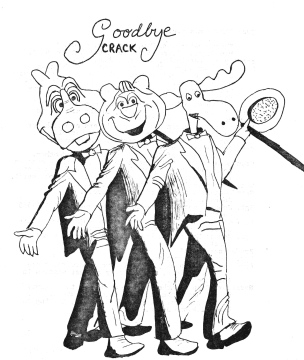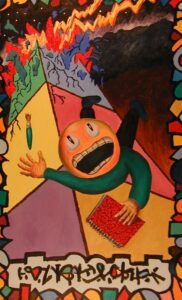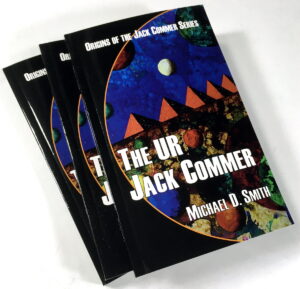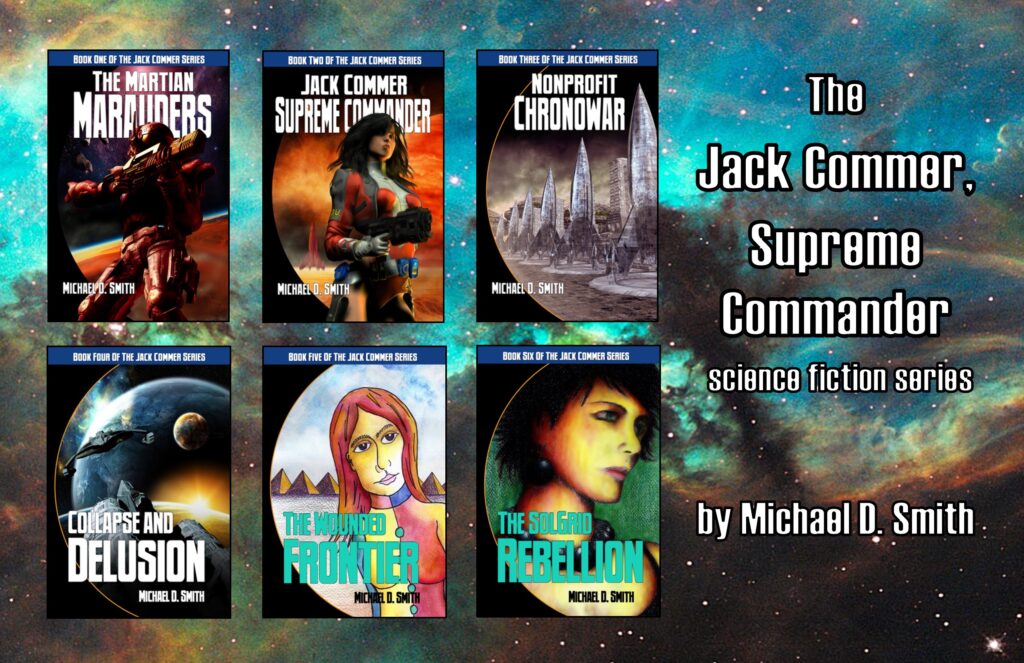As recorded May 30, 2021 at Smith Writing Studios. Alfred Moid Burlcron, a major character in my novel The Soul Institute, emerged as a recurring archetype as I prepared for the novel Caspra Coronae. I interviewed him just after speaking with archetype Aria Laci Coronae, who was delighted to take on the Caspra role in the novel and who also convinced me to change Caspra’s last name to her own. I was uneasy at the thought of the abusive Burlcron playing the shamanic wise man Marshall Singletree (originally named Tarat Lysander Mercer), but I knew Singletree would prove much more fragile than first indicated in the novel, and I hoped Burlcron’s pompous energy would give new insight into the character. But of course Burlcron ran in still more bizarre directions–and unexpectedly strengthened Caspra Coronae.
Session I

The Burlcron Archetype, digitally revamped oil pastel
Mike: Welcome, Alfred, Aria and I just finished up.
Alfred Moid Burlcron: Wow! Aren’t you lucky, to get to interview such a fine piece of ass!
Mike: What?
Burlcron: Oh, don’t sputter all over me! We archetypes are all buddies, we can say anything we want to each other, about each other, whatever we want. It’s all cool. So chill out, dude.
Mike: You–you’re stoned! I can’t believe it! You can’t be stoned for this!
Burlcron: Well, so what if I am? Burlcron was a big doper, y’ know. Only way he could hold his genius together, y’know.
Mike: Oh, man, this is gonna be a disaster. I need you to be Marshall Singletree.
Burlcron: Hell, I can do Singletree. Easy as 1-2-3. Don’t sweat it, man. Hell, you know I won’t do dope when I’m actually onstage.
Mike: Crap! Crap!
Burlcron: And note I’m dressed exactly for Singletree! Yeah, we all know you can’t describe anyone physically worth a damn. But get this: tight white turtleneck over this massive chest! Man, this guy has amazing pecs! The women go nuts for him! And no way the sweater can hide these huge biceps! And look at these forearms like hunks of iron! And these big freakin’ meaty hands!
Mike: Aw, geez, I never authorized Singletree to look like that! You’re Burlcron, fifty-something, balding, slender, taller than what I envisioned Singletree as, as a matter of fact.
Burlcron: Okay, okay, I paid Konceptual Body Design a helluva lot to fashion the ideal Mercer/Singletree character. It hurt, lopping four inches offa me, I tell ya! But I do anything for art. Puff up my pecs like this, musta done ten million reps with the barbells.
Mike: Oh, man. But I guess this will work for Singletree.
Burlcron: Yeah, admit it, dude, this is what you had in your mind’s eye all along. And get a load of these super-tight jeans. Not as tight as Aria’s luscious yoga pants, but you get the genitally-oriented picture, and I’m sure all my lady fans do as well. And I may be middle-aged, but look at this fantastic male tush! And these huge leather boots!
Sound: Bam!
Mike: Dammit, don’t slam them on my coffee table! Dammit, you cracked it!
Burlcron: Just like Mercer or Singletree would crack your puny narrow mind wide open! Face it, man, you need me in this damn book just the way I am! A massive combination of Burlcron and Mercer to become this Marshall Singletree dude! A true leader!
Mike: With flaws, with flaws, remember. Dammit, my coffee’s everywhere, all over my notes!
Burlcron: Hell with it, man. Just crap of the real world. Let’s talk about the damn flaws, man. Do I ever know about flaws! I’m your man for flaws! Like banging Jipo in the Soul Institute meadow where anybody could’ve seen us!
Mike: Dammit, I need help for this novel, and you’re just off on your ego trip!
Burlcron: I’m perfectly in character. Burlcron was nothing but ego trip, and this Singletree guy, well, as far as we all know, he’s just doing a damn good job of hiding his ego trip, even from himself. So … do I get the part?
Mike: Dammit. You know it’s too late for any of the Archetypes to get axed now.
Burlcron: But you get your petty revenge soon, when I get blown away in Part I. Man, that’s a waste of a major archetype, if you ask me.
Mike: I need you to just play the part, as written, as the Burlcron Archetype. Not the Alfred Moid Burlcron of The Soul Institute, but a combination of all those characters: Mercer, Burlcron, Randy Perrine, Larry Cathedral, Waterfall Sequence. Or Don Easterling, Mavory Deltrang, or Alexander Harper. Or Gaspard Toland, Harray Andreality, or the Gasoline Minister.
Burlcron: Hell, I know ’em all. No big deal. Could do this crap in my sleep. So you’re saying you’re not gonna let me ad-lib this thing?
Mike: Oh, hell, of course you can ad-lib, if you stay in character. In the Marshall Singletree character. We even want ad-libbing. It’s the whole channeling thing, you know. But Singletree may turn out to be harder than you think, because he’s really a tragic character, and your last major turn, in The Soul Institute, was comic.
Burlcron: I really got shafted in The Soul Institute. Arrested by the TSI cops, lost my wife, my daughter, everything. Humiliated. All because I wanted the best Soul Institute possible. Piss on that! The only work I’ve had since then is the 2019 Sortmind revision, and I was just needed to overdub a few lines for Gaspard Toland. I hope you remember that even though that was damn minor, I got a Heroes of Consciousness nomination for that bit.
Mike: Yeah, I remember. You really threw all your talents into a minor but necessary role there, and it worked. Thanks for that.
Burlcron: Look, Mr. Author. Mike. I mean really. I want to live. I don’t think Singletree really needs to die for his sins in the book. Sure he crumbled, sure he turned his back on his own principles, mainly because he wanted to stick it in Claudia more than he wanted to save humanity, but, hell, man, does he really have to die? Couldn’t he just become one more addict that everyone feels really sorry for and like, always freaked out about?
Mike: Interesting. Mercer/Singletree does have to come completely apart psychically in the novel. And if you could handle that scene, maybe there’s no reason he actually has to die. He just becomes a ruin, a passive burden to the new company.
Burlcron: Maybe he gets addicted to Revenge, and gets Walter for a Sponsor! Because Walter could never really prove he was addicted. Get this: Walter really did pull out his gun and point it at Singletree’s head, but he fired and missed! And Billy grabbed the gun away before Walter could fire again. Singletree’s now deaf in his right ear, or something.
Mike: On the other hand, his death at Walter’s hands is completely unexpected and shocking to the party, and shows how completely evil Walter is.
Burlcron: Yeah, but you’ll note that after he dies, the partygoers sort of continue the party just like before. No way that would work in real life, man, even in this weird dystopian society you’ve got going. What would really happen is that someone would call the cops and they’d show up and everyone would go home. Or get taken down to the station. No way Dave would go into his room and open his draft notice, just like that.
Mike: Huh. A convincing argument, I admit. I was truly set to have Singletree die. I see you’re getting into character after all. You’re sounding more like Singletree and not like Alfred Moid now.
Burlcron: Of course, of course! Another possibility is that I survive Walter’s shot, I’m broken and ridiculed like before, but now Walter is assigned as my addict.
Mike: That could lead you two in interesting directions in Part II. Is one of you the Phoxl Head?
Burlcron: Even though everyone knows you don’t want a Head.
Mike: Right. But the question remains: is one or both of you addicted, and who’s the Sponsor then?
Burlcron: In any case, Walter’s attempt on my life is what galvanizes Billy into taking command. Singletree can’t function in the army itself, he’s just sort of a hanger-on.
Mike: Okay, got it. But I really haven’t fully decided if Singletree lives or not.
Burlcron: Damn! Look, if he dies, maybe he comes back like Banquo’s ghost or something! Delivering wise, mystical, scary crap to everyone in the middle of the night, from beyond the grave. Maybe even in the shell hole.
Mike: Well, what he says wouldn’t be wise, because he’s been unmasked as a fool in Part I. Maybe he’d spurt out more nonsense that everyone knows to be idiocy. Ironic comments on what’s happening, like a Greek chorus.
Burlcron: Sheesh. I’ll do it either way, dude. Guess I have to. Don’t remember signin’ a contract, but hell, I need the damn work. You know you got me over a barrel, man.
Mike: C’mon, it ought to be an actor’s challenge, to play “Burlcron” in a different key. You’ll have to develop the weaker/Shadow side of Mercer/Singletree. Faking it, being unknowing and self-deluding.
Burlcron: You’re saying I don’t know how to act that kind of crap right now?
Mike: You’re going to have to work on developing that. Your ego-trip nature right now is preventing you from seeing Singletree’s flaws.
Burlcron: Crap! You can’t psychoanalyze me like that!
Mike: Sure I can. I have to. But I need you to see all this yourself. I mean, here we have Singletree, in all his false modesty about not claiming to be a real leader or a resolution to the Phoxl, nevertheless surrounding himself with worshippers, exerting his charisma to the max, bedding the much younger Reva to Kina’s total consternation, writing this book Liberating the F**k, all the while crowing about himself while claiming not to crow about himself. Claiming to lead humble Migrations with all this philosophical BS, mesmerizing everyone.
Burlcron: So the mother goes down hard. Maybe even needs to die. I can see that. Dammit. Maybe Part II needs to be totally void of Singletree.
Mike: It’s the only way Dave can eventually assume leadership. Otherwise he’d be looking at that Singletree shell and wondering “What would Mercer do?”
Burlcron: Yeah, I get it. Singletree buying the farm means total change.
Mike: And we need Kina numb, not just embarrassed on behalf of her father, pitying him, etc. He succumbed at the party, but then he went out cleanly. Even as a martyr.
Burlcron: Huh. Maybe you’re right.
Mike: I haven’t made my mind up yet, but going back and forth with you on this, I think we need his shocking death, and Billy’s order for Leon to bury the guy out in the pen.
Burlcron: Then won’t Billy also buying the farm in Part II repeat that?
Mike: I don’t think so. Billy will die a hero. And it all shows that innocent Dave, essentially third on the list, really has to ramp himself up to assume command.
Burlcron: Damn. Okay, I guess I can fit into this role and do a good job. Like I’m dressed for the Singletree part already, y’know. I had Konceptual cut four inches cut off my height. Maybe we need more. Like Burlcron is 6’4”, maybe Singletree should be much shorter than six feet. Like 5’9” or something.
Mike: Yeah, maybe.
Burlcron: Hell, I’m gonna need more dope for that.
Session II
Mike: You did it! You’re 5’9” now!
Burlcron: Yeah, it was a trip, all right. Konceptual has this robotic surgeon that whips off another three inches in like half an hour, but staggers it all over the body, like it’s not like they whack off your feet or anything and you know I did the whole thing on my lunch hour ’cause you know I wanna prove like I really want this part and all.
Mike: Great, great. I really appreciate it. You really do come off as Marshall Singletree now.
Burlcron: ’Course on such notice it turned out Konceptual ran outa dope, and all they had was this LSD! What a rush, man!
Mike: What?
Burlcron: Don’t sweat it, man, and it’s a really good thing, really, ’cause I can see that it’s like canceling out the marijuana and so things are getting even more like really, really serious about now and what was really weird was that I didn’t feel any pain with the first hack job ’cause I was so stoned, but man, you feel everything on acid and I shoulda thought of that before taking it but it was all they had and it was like, okay, I’m gonna go through this pain that’s like half an hour they said, but you know it felt like ten thousand years and like I experienced every shred of the pain and like, I didn’t care! You just don’t care anymore! Like, wow!
Mike: I can’t have Marshall Singletree on acid!
Burlcron: Why not, man, because like I’m in complete control now, in fact a lot more in control because like I say I’m canceling out the dope stone right now, which I admit scatters the hell outa your freakin’ mind but now this acid is clean, man, it’s restructuring the very me which I am!
Mike: God, God …
Burlcron: No, like really, I’m clear now! I see how to do this Marshall guy perfectly! I can act on LSD, you know! Anybody can! It’s so simple!
Mike: Maybe we’d better do Session II another time. If there is another time, and if I ever write this goddamn novel!
Burlcron: No, really, man, dig it! We need to throw a lot of really fantastic consciousness into this thing and now I’m it! I’ve got it all! Amazing, really, when you think about it, like, really, I’m both in control and out of control enough to have enough control to look at that cool table of characters you laid out for the novel after our talk last night, I mean really, I’m so in control I can analyze it just like I can analyze a Milton poem for English class! I swear to God!
Mike: Is this what lurks underneath Marshal Singletree’s savior-of-the-human-race exterior?
Burlcron: Yes! Yes! Exactly! The old coot is living the dream! The true spirit of consciousness! But nobody believes him because he’s insane. So he has to hide that. With this tremendous ego trip, and his turtleneck sweater! Like right now I’m amazed at your new table of characters, and for calling the novel Caspra Coronae! That’s what you did decide to call this damn thing and it’s perfect even though it won’t fly and it’s probably just a temporary thing but if you can get Caspra to really open up it’d be even more consciousness! Wow! Man, I saw Aria naked when she went in for her first session and I thought, wow, I mean, wow! She’s perfect for Caspra! Caspra’s so perfect even if what I’m saying can’t possibly make sense! Does that make sense? Man is she a piece! Can you let her know how bad I have the hots for her?
Mike: Well, c’mon, Alfred, look, I have no idea if anything I’m saying now means anything to you–
Burlcron: No! No, of course not! Wow!
Mike: But what I was going to say was that I needed to clarify the characters for the new novel, assign everybody an addict, and incidentally have Al Raavenscorr take on the Tommy Dreech/Bobby Holland role. I think having Al play so many different personas will work out well. From the reader’s standpoint, he’ll initially seem to be acting out of character at each step. That’ll be interesting.
Burlcron: Wow! Yeah! Let me do it! I’ll play both Al and Singletree! A dual role!
Mike: C’mon, man, you know that’s not possible. As for calling the book Caspra Coronae, well, if Caspra grows enough into her character that the novel could support that title, fine. Seeing the madness of crowds from her point of view might carry the book. Maybe not. In any case, it’s a decent working title. Or hell, I might call it something else tomorrow.
Burlcron: Call it Marshall Singletree!
Mike: Dammit, Alfred, are we seriously postulating that Marshall Singletree is insane? That some disturbing force in the Burlcron archetype means that he spends his whole life faking being the strong man, and then when Reva leaves him, he collapses in a second?
Burlcron: I’m not insane! I have control, man, I would never betray your cosmic novel like that! Because once my mind gets really raring, like I’m starting to see how I’d really merge into this Singletree guy cause like he’s really, really together most of the time, it’s just that he can’t handle sex! Well, who can, really, but maybe there’s this thing with his daughter, this Kina babe, like she’s jealous when her dad starts screwing Reva but what if there’s something weird going on with the two of ’em, I mean like Kina and Marshall, just like Burlcron had with his daughter Lisa in The Soul Institute? Which reminds me that I’m not kiddin’, man, I’d really like to get into that Aria Laci Coronae vixen in a second!
Mike: Oh, come on, Alfred, this is really out of line. You need to show respect to the other archetypes.
Burlcron: Well, you can’t have her! Aria and I happen to be great buddies, by the way, and we kid each other about sex all the time! Anyway, she says to me, like in the strictest confidence, man, that you were drooling for her!
Mike: I was not! Sure I was a little embarrassed at first, but so what? And I thought I made myself clear that as the commander of this task force I see all the archetypes as major forces to be respected! If I describe their bodies or their sexual acts it doesn’t have any bearing on my own life, it’s all part of channeling the forces into the novel.
Burlcron: You can’t control us!
Mike: I don’t want to control you. But I can and do send you into battle according to the needs of the novel!
Burlcron: That sounds like total fascism! No wonder this novel sucks! You’re a goddamn militarist is what you are!
Mike: Are you peaking on your LSD yet, mister? Are you going to get some brains back? Because I need you to give me some input on Part II!
Burlcron: Yeah! Bring Singletree back! Even if he’s dead! Maybe he’s just a corpse they carry around, like some holy relic.
Mike: What?
Burlcron: Yeah, like some of the worshippers just can’t let him go. When Billy orders Leon to bury him, Leon refuses and says Singletree’s comin’ with us, man, deal with it, man.
Mike: That’s–brilliant! Like the relics of some medieval saint! During an attack, he’s always carried to safety first!
Burlcron: Then whoever wants to hallucinate that he’s saying really wise BS just sneaks into the tent with the body bag and unzips it!
Mike: Oooh … yuck.
Burlcron: Like that was a real acid insight there, man.
Mike: Maybe he’s in the shell hole with Leon and Dave and Al and whoever.
Burlcron: Everyone’s in the shell hole! The whole main cast!
Mike: Well, that might be a stretch.
Burlcron: Get this: I play Singletree dead and rotting! Because of course the true believers think there can’t be any corruption! But there is! Who’s gonna admit it first?
Mike: And I still have to get everyone to Houston, and Stone Street. They find this old creaky cart and walk it down the I-45 shoulder. It takes them weeks.
Burlcron: They finally find a big wooden coffin and seal me in it, ’cause I do stink now! Kina’s a zombie by now! So’s Reva, but more from missing my huge member in her! I was the best thing she ever had, you know, or at least she thinks that, because of course Al’s really the best thing she’s ever had, but at any rate, and when they get to Stone Street, they put me up on the second floor of the main commune house! I have a room to myself there!
Mike: And you’re lit by candles all night long!
Burlcron: Yeah! Can you see it? I play myself rotting! With a few really eloquent soliloquies here and there! Like coming from Hades itself! Man, this is the role of a lifetime!
Copyright 2021 by Michael D. Smith
The interview is lightly edited to eliminate Burlcron’s worst vulgarity, and to spell out my abbreviations for various novels. I left intact various character names that I can’t expect a reader to know anything about.
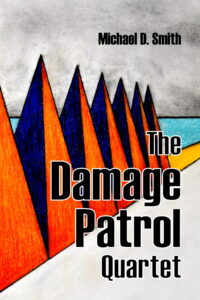 A feckless young architect falls in with a sixteen-year-old’s dubious trucking venture. Drug-addled Randy bemoans his fate as a slave employee in New Fascist Australia. An archeologist arrives on a tiny artificial gravity platform to give a scholarly lecture to barbarian colonists. And the Conscious Reach Corporation sets out to cure an entire city’s mental illness.
A feckless young architect falls in with a sixteen-year-old’s dubious trucking venture. Drug-addled Randy bemoans his fate as a slave employee in New Fascist Australia. An archeologist arrives on a tiny artificial gravity platform to give a scholarly lecture to barbarian colonists. And the Conscious Reach Corporation sets out to cure an entire city’s mental illness. Roadblock
Roadblock





